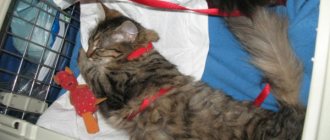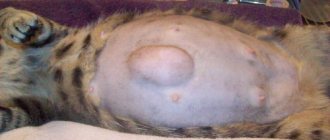Description of the pathology
The cat's eye is a precise, complex and fragile instrument. Damage to any of its structural components can cause vision loss.
In medical and veterinary practice it is customary to distinguish:
- amaurosis or absolute loss of vision;
- scotoma or partial loss of visual fields;
- hemianopsia - loss of half the visual field.
Blindness can be acquired or congenital. The animal may become blind in one eye or both. There are many reasons for the development of this pathology. Moreover, if some of them are eliminated, the animal’s vision can be partially or completely restored. But there may be cases when damage to the organ of vision is irreversible and the animal remains blind for the rest of its life.
What to do to restore the animal's ability to see?
Drug treatment of pathology depends on the causes of its occurrence, in some cases they resort to surgery.
The treatment regimen depends entirely on the established diagnosis. If the cause of blindness is inflammatory processes in the body, a course of antibiotics and anti-inflammatory drugs is prescribed. For glaucoma, therapy is aimed at reducing ICP; normalizing blood pressure will be necessary if hypertension is the root cause of the pathology. For cataracts at the initial stage of development, the doctor prescribes special ophthalmic drops; if the disease is advanced, you will have to undergo surgery to replace the lens.
Signs of blindness in cats
Since the cat cannot tell the owner about its problem, he can only observe the actions of the pet.
The following signs should suggest a loss or deterioration of vision:
- unsure gait;
- collision with objects;
- refusal to jump;
- difficulty controlling successive steps, the cat starts running and suddenly stops;
- the animal's eyes do not glow in the dark;
- a large number of broken vibris appears;
- The animal does not concentrate its gaze (looks into nowhere).
Signs of blindness should not be confused with features of the cat’s central nervous system. Animals see moving objects better. Therefore, the cat may not pay attention to the frozen owner and jump away when he moves.
In complete darkness, no mammal can see. Felines can navigate well in the twilight, with minimal light, so they see well at night. But if there are no light sources at all, the animal will behave as if it were blind. Because it will not be able to recognize surrounding objects.
Cats have difficulty distinguishing objects located at a short distance in front of their eyes. The optimum at which these animals can see perfectly is 2-6 meters. They explore everything that is closer using smell and touch. Therefore, a cat poking its nose into a bowl of food is not blind at all. She examines food, determines its suitability and temperature.
Overcoming blindness from birth
A creature born without visual function or blinded early needs constant care. In an urban environment, it is not difficult to provide such care, especially since the kitten quickly gets used to a familiar environment.
It is important to rearrange furniture in the apartment less often. Free walking of the pet is also excluded. A tailed disabled person should exercise only with the owner guiding him with a leash.
Such a companion will follow the person always and everywhere, like a devoted dog. A blind pet's excellent hearing will allow it to instantly respond to its owner's voice. A blind animal will not refuse toys equipped with sound signals.
A creature born without visual function or blinded early needs constant care. In an urban environment, it is not difficult to provide such care, especially since the kitten quickly gets used to a familiar environment.
Blindness in cats is most often an acquired defect. Its occurrence can be judged by a change in disoriented behavior or a clouded look. Modern ophthalmological examination methods will allow you to confirm the diagnosis.
Accurate identification of the cause of the pathology increases the chances of vision restoration.
However, for pet purrs, blindness is not a death sentence. Owners will not have any special problems if they follow the rules for caring for a disabled pet.
Puppies lack two senses at birth: sight and hearing. It takes at least 10 days, and sometimes several weeks, for their development. Although the lack of vision and hearing may seem strange to you and me, puppies develop in a manner that is evolutionary and beneficial to their species. But why does this happen? And when do puppies' eyes open?
Causes of vision loss in cats
A cat can lose vision abruptly, almost instantly, or lose it gradually, adapting to the fact that the visual image enters the brain in a reduced volume or of poor quality.
There are more than 20 common causes of vision loss in cats. You can systematize them and consider the main groups.
Causes of sudden vision loss
The cause of blindness can be injury to the eye itself or a concussion. Optic neuritis, or inflammation of the optic nerve, can be caused by demyelination of nerve tissue or by infectious agents affecting the nerve. Depending on the type of neuritis, there may be a narrowing of the visual field, pain when moving the eyeball, and complete blindness.
Hypertension can cause sudden blindness and lead to a slow decline in visual function. In the event of a sharp increase in pressure in a cat, small vessels are damaged, blood penetrates into the tissues outside the vessels. This can trigger retinal detachment, causing the cat to go blind. In some animals, with a sharp rise in blood pressure, hemorrhage is observed in the anterior chamber of the eye. Such a hematoma is easy to notice with the naked eye. Hypertension is one of the most common causes of blindness in cats.
Causes of slow vision loss
Age-related changes in cats, like in people, are inevitable. As older animals age, the retina may atrophy. This causes a gradual decline in visual function.
Neoplasms in the eye itself and affecting the visual centers in the brain can cause decreased and complete loss of vision. Other symptoms are also observed with malignant tumors. Weakness, changes in the size and shape of the eye. Tumors in the brain may cause behavioral disturbances, nausea, vomiting, and loss of consciousness in animals.
Glaucoma is a collective name that unites a group of pathologies based on increased intraocular pressure. In this case, the cat suffers from headaches, becomes irritable, and the field of vision is seriously narrowed, even to the point of complete blindness. The affected eye increases in size and bulges out of the socket.
Inflammatory diseases of the cornea (keratitis) and the vascular system of the eye (uveitis) can cause loss of vision in a cat. In this case, the owner may notice clouding of the cat's eyes, watery eyes and frequent washing. The animal actively rubs its sore eye with its paw.
Cataracts, or changes in the transparency and refractive power of the lens, lead to a decrease and, over time, complete loss of vision. As a result of uncontrolled diabetes, your pet may lose his sight. Some types of chlamydia cause severe eye disease in cats and can cause blindness.
Nutritional errors, in particular hypo- and avitaminosis, can cause decreased vision and even blindness. In this case, replenishment of this deficiency can lead to complete restoration of vision.
Diagnosis and treatment
The usual set of procedures for deteriorating vision in an animal includes:
- collection of biological fluids (blood, urine) for analysis;
- blood pressure measurement;
- examining a cat's eyes using an ophthalmoscope.
Some clinics have equipment to measure eye pressure. A veterinary ophthalmologist can diagnose many pathologies by carefully examining the cat.
The treatment tactics should be chosen by a veterinarian. Eliminating the root cause of blindness or stabilizing the animal's condition, if possible, plays a big role. For example, the fight against persistent hypertension or infections.
If the cat is blind, the caring owner will have to make some concessions to make the animal feel more comfortable. Objects should be in their usual places. It is not recommended to move the bowl, drinking bowl and sleeping place of a blind pet. A blind cat should not be allowed to walk independently. You need to talk to him, play with him and pet him more than a healthy cat. This way the animal will be able to understand, stop being afraid of losing its home and the love of its owner, and will be able to better adapt to its difficult condition.
How to care for a sick pet: features
Blind cats that live in an apartment or house often adapt to this situation. It is important for the owner to follow certain rules and, of course, love his pet. First of all, you should give up free range. If your cat likes to walk outside, this can only be done with a leash. It is recommended not to make drastic changes in the apartment, so as not to disorient the cat. Young blind cats love active play, so it is recommended to use toys that make sound signals. Otherwise, you need to care for such animals in the same way as healthy relatives. Don't forget to visit your doctor periodically.
Videos and Illustrations
Cloudy eyes in cats. Veterinary clinic Bio-Vet
Glaucoma
Keratitis
Uveitis
The blind eye does not glow when hit by light
leave a comment
*This page refers to the section on cats' eyes.
Sudden blindness
- a very alarming and unpleasant disease of cats. Affected cats, without sufficient time to adapt, experience severe disorientation and may behave in strange and unusual ways. A cat can move haphazardly, crash into various objects, and be constantly in a state of stress. The matter is complicated by the fact that the resulting blindness is not always obvious to the owner, and can be identified by a veterinarian when determining the reasons for the cat’s strange behavior.
One noticeable sign of a cat's blindness is that the pupils (the dark central part of the eye) become permanently dilated.
Causes of blindness in cats.
Blindness can be caused by many reasons. Some causes lead to gradual, slow deterioration of vision, and in these cases, cats are often able to adapt surprisingly well to the visual impairment, showing little or no signs that they are experiencing any difficulties. However, if blindness develops quickly, the cat does not have time to adapt and experiences significant difficulties in orientation. Among the causes of sudden blindness are the following:
Optic neuritis.
In this condition, the optic nerves (nerves that transmit visual information to the brain) become inflamed and, as a result, no longer function, leading to blindness. This disease is very rare in cats.
Hypertension (high blood pressure).
Hypertension
- a common disease, one of the main causes of sudden development of blindness in cats. High blood pressure can damage the small blood vessels at the back of the eye, causing the blood vessels to bleed, or leak fluid. This in turn can lead to a detachment of the retina (the layer of light-sensitive cells that are located at the back of the eye and allow us to see). Having detached, the retina can no longer perform its functions, causing the cat to go blind. In some cats, high blood pressure can cause some bleeding towards the front of the eye, which can be easily noticed.
Brain diseases.
Because visual signals are transmitted through the optic nerves to the brain, which processes them, brain problems (caused by infection, inflammation or tumors) can potentially lead to blindness in a cat.
Retinal degeneration.
Like humans, cats can suffer from degeneration of the layer of light-sensitive cells at the back of the eye (retina), which is responsible for vision.
Care and maintenance
The content of the article
Cats are one of the most powerful and agile predators relative to their body size. These animals' senses allow them to lead a full life. Cats rely on their senses of sight, smell, touch and hearing to survive in the wild. Therefore, blindness in cats living in the wild is something of a death sentence.
Of course, old age is not the only cause of blindness.
If the cat begins to see poorly, then it will gradually get used to it and adapt to its new position. In turn, the owner must make an effort so that the blind cat quickly adapts and begins to lead a full life again.
Causes of blindness
There can be many reasons why a cat is blind. Some of them contribute to the rapid development of blindness, while others cause the cat to slowly lose its vision.
The reasons that a cat becomes blind can be roughly divided into 3 categories:
- congenital disease;
- consequence of injury;
- a consequence of an acquired disease.
Everything is more or less clear with the first two reasons. A cat can be born blind, in which case it will adapt to the lack of vision from birth. Cats can also lose their vision as a result of injury.
Most often this happens to street cats that have suffered from attacks by other animals. It is good if such animals are lucky enough to meet a worthy owner who will provide them with a fulfilling future life.
What diseases can cause vision loss:
- High blood pressure. This is the most common disease that can cause a cat to go blind. The pathology causes damage to the blood vessels in the back of the eye, which can contribute to retinal detachment. The retina is the light-sensitive cells responsible for vision. The detached retina stops performing its functions, causing cats to become blind.
- Optic neuritis. The disease is an inflammation of the optic nerves. As a result, they lose their functionality, causing blindness to develop. This pathology is very rare in pets.
- Brain diseases. Because visual signals are sent to the brain through the optic nerves, tumors and inflammation in the brain can cause blindness.
- Retinal degeneration. People can also suffer from this pathology. It occurs when the layer of light-sensitive cells degenerates. The disease usually has a slow course, as a result of which the animal that suffers from it gradually adapts to its new conditions. In some cases, an animal suddenly becomes blind due to retinal degeneration.
- Uveitis. This disease is otherwise called inflammation of the vascular system in the eyes. Usually accompanied by soreness in the eyes and noticeable redness. Cats often do not become blind from uveitis; they only experience a decrease in visual acuity.
- Cataract. Cats who are close to old age are usually blind from this disease. Cataracts cause clouding of the lens of the eye. With this disease, the cat gradually loses its vision.
Animals have the ability to adapt to changing conditions. Therefore, owners may not immediately notice that the cat has become blind. Signs that indicate a cat is losing vision:
- exercise caution when moving around the apartment;
- almost complete refusal to jump;
- a blind cat will crash into objects that were in their usual place;
- the gaze is not concentrated, there is no reflection from the eyes;
- there are broken mustaches;
- the animal sometimes stops when walking and has poor control over the sequence of steps.
There are several rules that should be followed when there is a blind animal in the house:
- Familiar indoor environment. It is bad to rearrange the apartment where a blind animal lives. A blind cat has its own “map” in its memory, based on which it finds its way to food bowls, a tray and other things. It is important that these objects familiar to the animal remain in their places. If rearrangement in the apartment is inevitable, then after it it is necessary to show the animal the way to its newly located places. To do this, you need to carry the animal in your arms, allowing it to sniff.
- Conversations. A blind Persian or Bengal cat, a blind animal of any breed will need to be talked to. Why is this so necessary? It’s simple - hearing the owner’s voice, the animal calms down mentally. Therefore, when entering a room with a blind cat, it is best to call her by name. One fact is also known: an animal deprived of vision often does not remain in place, but with its “tail” follows its owner, who acts as a guide.
- Prohibition on independent walks. Some owners let their pets walk alone on the street. This is unacceptable for blind cats. Blind animals can be walked on a harness, where a tag with the owner’s contact information will be attached. A tag is necessary in case the animal suddenly escapes from the harness. A blind animal will feel at ease in a country house with a fenced area. When bringing such a cat to your dacha, you should carefully check the fence of the area for damage and holes into which the animal could escape.
- Games. Since blind animals tend to be sedentary, they need to be played with more often to help maintain normal physical condition. They need to be entertained more often with sounds to which they will respond. Various toys from the pet store, such as rattles or bells, are suitable for this purpose.
We invite you to familiarize yourself with: White cat with blue eyes description of the breed, nature, care features
Partner news
If you notice that your pet is having vision problems, contact your veterinarian as soon as possible. Place the cat in a safe and quiet place until the cause of the vision loss is determined. Limit your pet's access to the pool, stairs, balconies and hot water. Don't leave your cat unattended.
Place food and water not far from the animal so that he can easily find them; if necessary, help him; you can use a leash for this.
Do not allow your cat to scratch its eyes, as this may cause injury or infection. If necessary, use an Elizabethan collar.
Cat breed: Persian. Asks: Svetlana Antropova. The essence of the question: The cat’s pupils are dilated over the entire eye, what should I do?
The cat's pupils are dilated over the entire eye. Doesn't respond to light. He doesn't eat well. I am very worried.
Diagnosis of sudden blindness in cats.
The first step is for the veterinarian to verify that the cause of the clinical signs exhibited by the cat is blindness. To do this, as a rule, it is enough to carry out a few simple tests.
Once blindness is confirmed, further testing is required to identify possible causes.
- Careful eye examination - Many causes of blindness can be detected by simply examining the eyes with an ophthalmoscope (an instrument used by doctors to examine the internal structures of the eye).
- Blood pressure measurement - performed because one of the common causes of blindness in cats is hypertension. This is easier than it sounds and is usually done, as in humans, with a special cuff wrapped around the paw. Pressure is measured by inflating and deflating the cuff.
- Urine and blood tests - usually done to detect underlying medical conditions. For example, chronic kidney failure often causes high blood pressure in cats. Brain scans – In some cases, especially when brain disease is suspected, veterinarians will order an MRI or CT scan. Such procedures are carried out in specialized clinics.
Diagnostics of visual function
A pet showing signs of low vision should be seen by a veterinary ophthalmologist. Visual inspection is carried out using special optical instruments with magnification and lighting functions. Such diagnostics will allow:
- determine whether the cat’s pupil reacts to light;
- check the transparency of the lens;
- notice changes in the optic nerve.
We invite you to read: Sphynx Peterbald breed: description and character of St. Petersburg cats
More complex methods - video ophthalmoscopy and electroretinography - will make it possible to diagnose the condition of the retina and identify the degenerative processes occurring in it. Using tonometry, glaucoma is detected or excluded.
An ultrasound of the eyeball is prescribed to determine the position of the lens, a detailed examination of the retina, and detect tumors in the vitreous body. Sometimes, to obtain a picture of brain tissue and identify inflammatory processes in the internal structures of the eye, MRI is used.
Biochemical and laboratory tests of blood and urine complete the clinical picture. On their basis, chronic internal diseases such as renal failure, diabetes mellitus and other pathologies associated with blindness are diagnosed.
- determine whether a cat's pupil reacts to light,
- check the transparency of the lens,
- notice changes in the optic nerve.
More complex methods, video ophthalmoscopy and electroretinography, will make it possible to diagnose the condition of the retina and identify degenerative processes occurring in it. Using tonometry, glaucoma is detected or excluded.
Caring for a blind cat.
Even if the blindness has become permanent, cats usually adapt very well to vision loss. They perfectly compensate for vision with other senses - hearing, smell and touch (using vibrissae to prevent collisions with objects). However, sudden loss of vision is very stressful for cats. They may bump into objects in the house, or hide in places where they feel safe.
In order for a blind cat to feel normal, certain changes will have to be made that will make their life easier. Furniture and resources (food, water, bedding, trays) should be in the same, easily accessible place. Care should be taken to avoid noisy activities, children should be taught to move carefully so as not to frighten the cat, who cannot see them.
Blind cats should live indoors, going only to closed areas where they cannot get lost or be attacked by other animals. After some time, living in a constant environment, most blind cats adapt well and live quite happily.
How to determine pathology?
An unsteady gait and cautious, slow movements may indicate the animal is blind.
If an old or young cat for some reason has ceased to see normally, you can understand that something is wrong with the animal by the following symptoms:
- Careful, slow movements in a familiar room.
- In an unfamiliar place, the animal tries not to move, looks closely for a long time, and bumps into objects.
- The cat refuses to jump or climb to heights.
- The gait becomes unsteady.
- The gaze is cloudy, the pupils are large, and do not respond to light stimuli.
- The cat becomes shy, fearful, and nervous.
Forum KOTODOM
Many cat owners do not even suspect that their proud pet is gradually losing his sight. Blindness in cats can be reversible or irreversible, partial or complete. What can cause blindness in cats?
1. Cataract. Cats can also develop cataracts. This is a condition in which the lens of the eye becomes cloudy. Cataracts usually develop due to eye injury, diabetes, or a genetic problem. Cataracts are treated surgically.
2. Glaucoma. A tumor, injury or any other hereditary disease can lead to excess pressure in the eyes, which can result in glaucoma. This is a common cause of blindness in cats. Glaucoma is treated by lowering intraocular pressure.
3. Tumors. Tumors of the eye often lead to blindness. In many cases, the eye has to be removed surgically.
4. Progressive retinal atrophy. This is an incurable disease and is most likely hereditary. This is a very slowly developing disease, under the influence of which the cat gradually completely loses vision. Because the disease progresses slowly, cats learn to cope with the gradual loss of vision and can live with vision loss.
5. Hypertension. Cats with kidney disease and diabetes are predisposed to hypertension. Hypertension can contribute to retinal detachment due to an overactive thyroid gland or kidney disease. There is no specific treatment for hypertension, but the cat should be kept on a salt-free diet.
6. Conjunctivitis. This infection causes the inner eyelid to become red, swollen and itchy. Although conjunctivitis does not cause complete blindness, repeated infection can cause blurred vision. Treatment may be in the form of eye drops or oral medications depending on the cause of the infection. There are other causes of blindness in cats, including: trauma, retinal degeneration, neoplasia, hypoxia, congenital underdevelopment of the optic nerves, and encephalitis. It is very important to make a correct diagnosis, since treatment will be determined by the diagnosis. In many cases, blindness is the result of hidden disorders or diseases that have a significant impact on the cat's health. Sudden blindness in cats is usually provoked by hypertension, thyroid disease, and kidney disease.
Signs of blindness in cats: 1. The cat constantly bumps into objects. 2. The cat has poor control over the coordination of paw movements. 3. Cloudiness of the eye or dilation of the pupil even in bright light. 4. Noticeable clumsiness of the cat. 5. The cat cannot find a cup of food or water. 6. The cat sleeps a lot and is inattentive. 7. The cat gets scared easily and seems timid. 8. The cat refuses to play and does not hunt.
Caring for a blind cat, of course, falls entirely on the owner. The first thing to do is take your cat to the vet as soon as you suspect vision problems. If your cat partially or completely loses its vision, do not abandon the poor animal under any circumstances. After all, this is cruel. Treat her the same way you would treat a blind person. A blind cat is quite adaptable and uses other senses to compensate for the loss of vision. Make sure your cat doesn't wander outside alone for long periods of time. Let your cat outside only under supervision. You can put a collar and leash on your cat and take her for a walk on a leash. Label the collar with your name and address in case your cat gets lost. A blind cat can walk around the house on its own. Cats have scent glands on their paws that leave a trail that cats can easily follow. You should not carry your cat around the house in your arms. Let your cat be independent. Limit your cat's movement near hot water, balconies, and stairs, as near these dangerous places an accident may occur with a blind cat. When approaching the cat, talk to it so that it does not get scared. If the cat is blind in one eye, approach it from the side of the sighted eye. Do not move furniture, tray, or cup of food unless absolutely necessary. Unexpected changes can disorient a blind cat. When playing with your cat, use toys that make sounds, this will help your cat maintain physical fitness and enjoy life.
Blindness can cause a feeling of helplessness in both the animal and the owner. But cats have a strong will and quickly adapt to this condition. This requires support, attention and care from the owner. A blind cat is still your cat and should be cared for like a healthy cat.
CONSULT A VETERINARIAN (812) 607-68-62
Cats can lose their vision for a variety of reasons. Vision often weakens with age, but due to injury or disease, even a kitten can go blind. What to do if your cat is blind? How to help?
Firstly, you need to take a healthy approach to the situation. You should not try on the loss of vision on yourself and transfer the terrible human experiences about this to your cat. Cats themselves are unlikely to be prone to getting emotional and causing tragedy; Blind domestic cats can lead normal lives and feel happy. A blind cat needs help, but not pity.
Secondly, you should definitely consult a good veterinarian. The doctor will be able to correctly diagnose, prescribe the necessary treatment and advise special care for a blind cat . What if, under certain conditions, vision can be restored? Or maybe the loss of vision is partial, and proper care will prevent complete blindness? In any case, a blind cat should be regularly shown to a veterinarian to monitor its eyes and general health.
Thirdly, it depends mainly on the owners themselves how comfortable and fulfilling their pet’s life will be day after day.
Returning the ability to see
What to do if it turns out that your cat is losing sight? First of all, don't panic. In many cases, doctors are able to restore visual acuity. The choice of treatment program depends on the identified pathology:
- for hypertension, the main task is to normalize intraocular pressure (this is achieved not only by taking medications, but also by a salt-free diet),
- inflammatory processes are “quenched” with antibiotics and antiphlogistic agents,
- to enter the remission stage of chronic diseases, renal failure, diabetes mellitus, immunostimulating drugs and vitamin complexes are used,
- in case of cataracts, when the cat has a cloudy pupil, it is possible to perform an operation to transplant an artificial lens (the transplanted lens allows light to penetrate the retina and add contrast to the image),
- eye tumors are removed through surgery.
Given the high adaptability of cats, problems with vision, which is lost gradually, can be identified at fairly advanced stages. The pet becomes less mobile, sleeps more, prefers to move exclusively on floor surfaces, which does not cause much concern for the owners. Blindness in a cat can be determined by a number of the following signs:
- Careful movement around the home.
- It is difficult for a cat to control the sequence of steps; while walking, the animal stumbles into an amble and stops.
- A large number of broken whiskers are observed. With complete or partial loss of vision, the cat “feels the world” and picks up air vibrations with its whiskers.
- There is no reflection of the eyes in the dark, but in the light, the gaze is deconcentrated.
- The animal crashes into objects that are not in their “usual” place.
The characteristics of the cat's central nervous system explain a number of nuances that can be mistaken for vision loss if the pet cannot see.
Cats can lose their vision for a variety of reasons. Vision often weakens with age, but due to injury or disease, even a kitten can go blind. What to do if your cat is blind? How to help?
Firstly, you need to take a healthy approach to the situation. You should not try on the loss of vision on yourself and transfer the terrible human experiences about this to your cat. Cats themselves are unlikely to be prone to getting emotional and causing tragedy; blind domestic cats can lead a normal life and feel happy. A blind cat needs help, but not pity.
Secondly, you should definitely consult a good veterinarian. The doctor will be able to correctly diagnose, prescribe the necessary treatment and advise special care for a blind cat. What if, under certain conditions, vision can be restored? Or maybe the loss of vision is partial, and proper care will prevent complete blindness? In any case, a blind cat should be regularly shown to a veterinarian to monitor its eyes and general health.
Thirdly, it depends mainly on the owners themselves how comfortable and fulfilling their pet’s life will be day after day.
1. Cats who have lost their sight rely heavily on their memory. If a cat loses its vision gradually, it may behave as usual within the confines of a familiar home. Owners notice something is wrong after renovations or rearrangements when their pet suddenly starts bumping into everything. So try to maintain stability in your home.
Do not rearrange the furniture, and if you rearranged it, for example, when guests arrived, return everything back. Bowls with water and food, the tray should be in one place! If the room is new, you need to patiently accustom the cat to each place, placing the cat next to them (directly in the tray - in the case of a tray) and allowing the cat to find its way from these most significant to not objects to other parts of its possessions.
2. Make the environment safe - remove all sharp objects, wrap treacherous corners with soft materials, block open staircases and fireplaces, and exits to the balcony. Do not leave boxes, shoes, umbrellas, toys, etc. scattered on the floor. – now it’s not only a matter of order, but also of convenient movement of the cat around the house.
3. Home is the safest place for a cat that has lost its sight. It is highly recommended not to release it into the outside world! But if the cat is used to walking on the grass, basking in the sun and continues to persistently ask for a breath of fresh air, it is not necessary to deprive her of this pleasure. Only now she must be accompanied on walks, and if she is trained, she must be walked on a leash.
Under no circumstances should you leave her alone on the street - except in her own courtyard, closed from external dangers, where the cat is familiar with everything, and caring owners have removed or securely covered all dangerous objects, pits, pools, etc. If there is a possibility that a blind cat will end up on the street, then on the collar it is worth indicating not only the coordinates of the owners, but also information that the cat cannot see.
4. In cats that have lost their sight, other senses become more acute - smell, hearing. This is worth using to help your cat navigate. For example, you can “mark” rooms with different subtle scents so that your cat always knows where he is. Strong and unpleasant odors should be avoided!
We invite you to read: Enterosgel for cats: therapeutic effect, instructions. Video
5. Talk like a cat! In this case, it is not a quirk, but a necessity; it makes her feel safe and calms her down. She hears that someone has entered the room - say something to her, let her know that it is you! Talk to her before petting or picking her up, otherwise she may get scared out of surprise, not accept affection, and even bite or scratch.
6. Avoid sharp, incomprehensible, frightening sounds. If something falls in the kitchen with an unimaginable crash, find the cat, pet it and calm it down.
7. If there are several animals in the house, you can put collars with trinkets on them to warn the cat of their approach with a characteristic sound. A blind cat may also rely on other cats to navigate around the house. Here is an amazing case of how a cat became a guide for a blind dog.
8. A blind cat is first and foremost a cat, so play with it. Rustling, mouse-like squeaking, buzzing, tinkling things are suitable as toys. The cat will love to follow the sound. When hunting, even playfully, a cat feels like a cat. Help her with this!
Gwen Cooper's book “Homer's Odyssey” tells the true story of a blind kitten who not only lives a full life as a cat (moves freely around the house, makes friends with two other cats and catches flies better than them), but also becomes a real superhero. So, he stopped a burglar who broke into the house, inspired her to write a book and helped the owner meet the man of her dreams. – Recommended reading!
Especially for the site, Maxim Naumov
Pictured is Gwen Cooper with her cat Homer
Of course, caring for a blind cat will be unique, but still not particularly difficult. The behavior of a blind animal will also differ from that of a healthy cat. I will talk about this below.
What diseases can cause a cat to go blind? Eye injuries, congenital defects, conjunctival diseases, tumors, glaucoma, cataracts, hyperthyroidism, dry eye syndrome.
A cat has been diagnosed with blindness: is there a chance of regaining vision?
Help her with this!
Gwen Cooper's book “Homer's Odyssey” tells the true story of a blind kitten who not only lives a full life as a cat (moves freely around the house, makes friends with two other cats and catches flies better than them), but also becomes a real superhero. So, he stopped a burglar who broke into the house, inspired her to write a book and helped the owner meet the man of her dreams. — Recommended reading!
Especially for 33cats.ru, Maxim Naumov
Pictured is Gwen Cooper with her cat Homer
20.02.2013










